Microcement in exterior to create luxury spaces
The limits to create decorative solutions on the surfaces of the house are our own imagination and our aesthetic concerns. The microcement in exterior is the perfect coating to create more luxurious and resistant decorations.
It is a material designed for decoration lovers who seek to enhance the environment of the house and make exquisiteness their reason for being. The exteriors of microcement lead us to connect with our own style, even before entering the house.
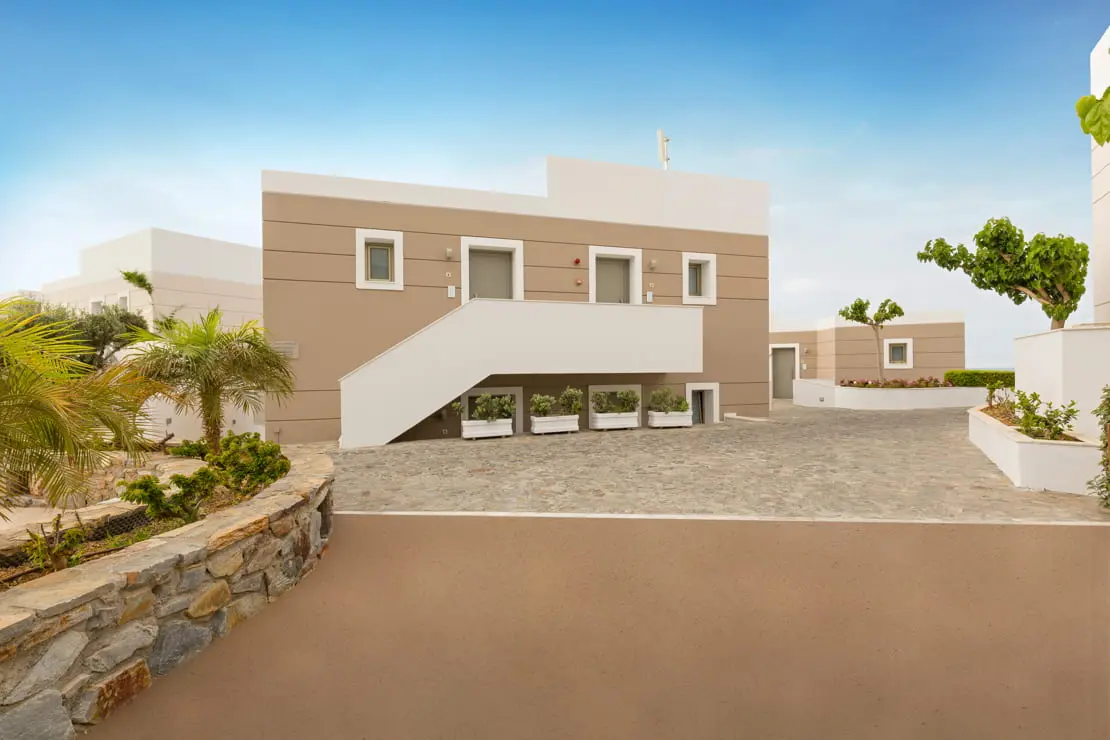
The microcement in exterior perfectly reflects the new ways of understanding space and allows integrating different surfaces. It is opening a path without obstacles to innovate and create personalized spaces. Why bet on this coating in outdoor spaces?.
- Microcement in exteriors creates continuous surfaces without joints, which translates into pavements of a single piece. They are perfect for enhancing the spaciousness and brightness of gardens, porches, facades or swimming pools.
- It has a thin thickness, of just 3 mm, which does not prevent its application outdoors. Its hardness makes it a material resistant to cracking and weather conditions.
- Allows coating floors without having to remove the existing surface or modify the ground level. It transforms the support and without raising debris.
- It has excellent adhesion, which allows achieving unique finishes on all types of supports.
- Microcement pavements are resistant to impacts, temperature changes, and ultraviolet rays.
- The microcement pavement neither contracts nor expands with temperature changes.
- It is ideal for cladding walls, stairs and terraces. It can also be combined with other outdoor materials.
- The sealant applied to microcement surfaces implies that the coating is endowed with waterproof properties. This functionality translates into a guarantee of safety, a factor especially important in rooms that are exposed to permanent contact with running water.
Microcement finishes in exterior
The need to connect with our own style and design unique spaces makes microcement the best option for coating outdoor pavements. It is the best ally to create cozy surfaces with high decorative value.
If you are thinking of covering an exterior surface with microcement, here we reveal a series of finishes for you to get inspired and achieve inspiring surfaces.
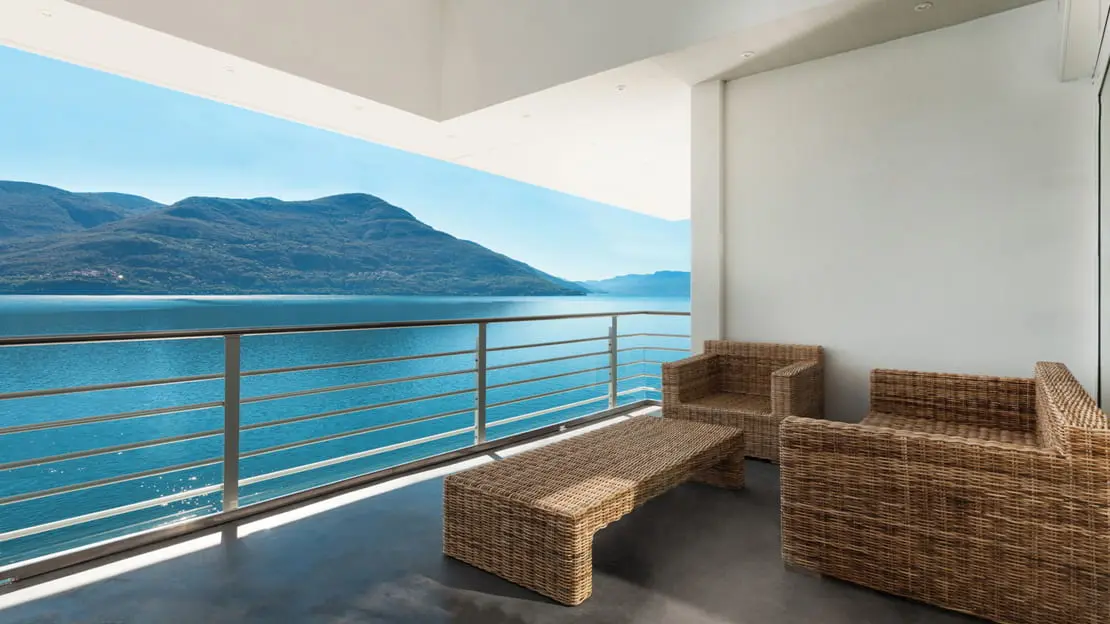
1. Microcement in exterior to beautify spaces
On this balcony, the microcement creates a continuous floor that integrates perfectly into a decoration based on light tones and rustic furniture. The coating enhances a privileged environment where elegant finishes and nature go hand in hand on this occasion.
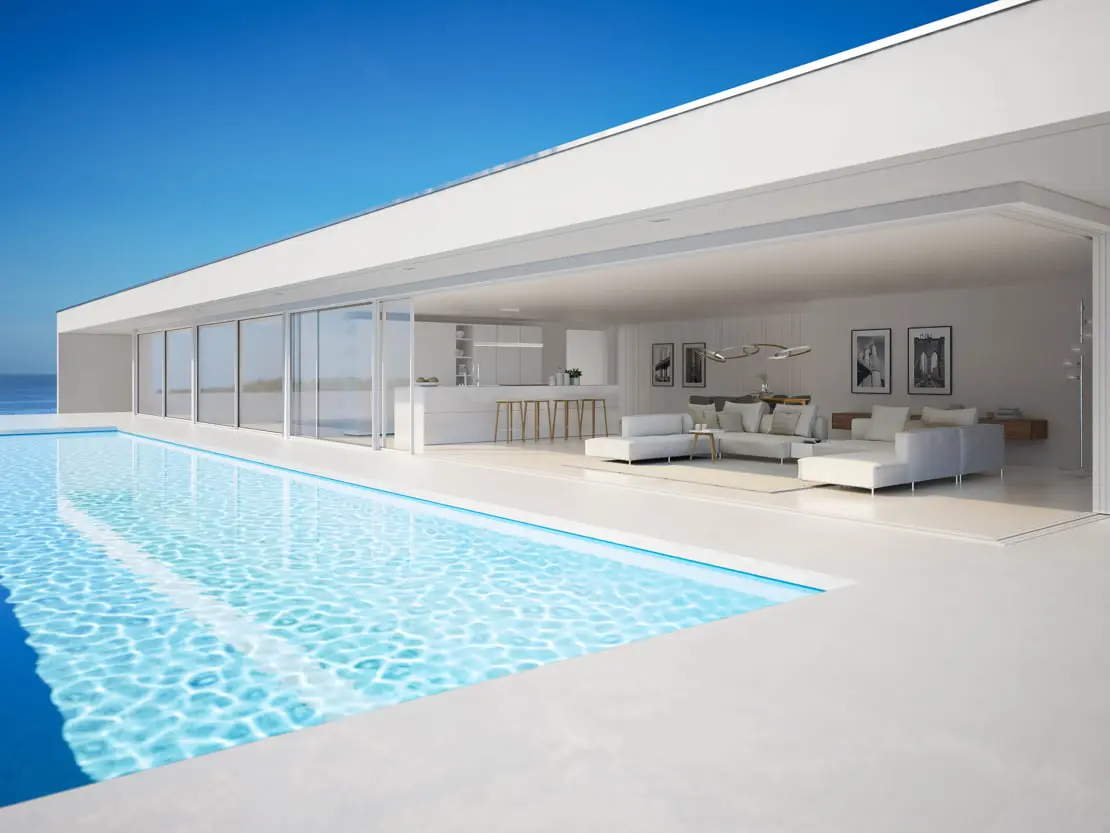
2. Microcement pool to achieve incredible designs
If microcement in exteriors is successful, it is because it integrates perfectly with any style and landscape. This microcement pool is an example of how to achieve a very special design. The coating joins the terrace and the pool achieving a visual continuity and an unparalleled sense of exquisiteness.
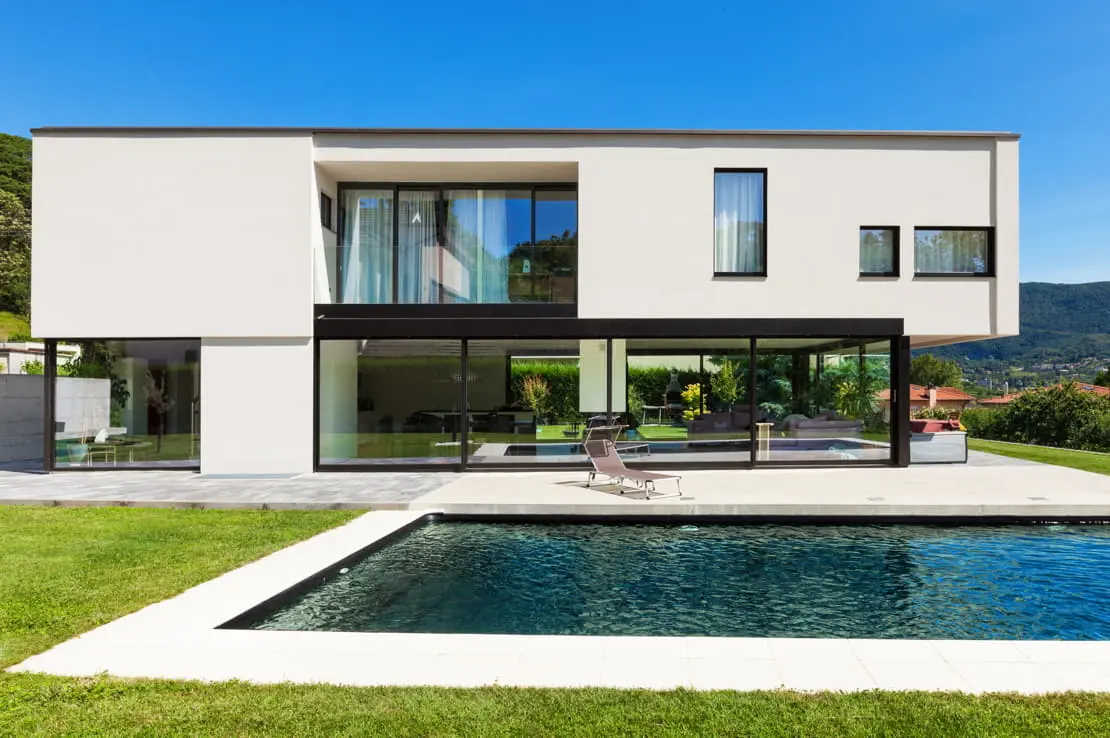
3. Exteriores de microcemento para unir lujo y naturaleza
The microcement in exterior gives us spaces where luxury coexists with the most enveloping nature. The floor is coated with microcement creating a clean pavement. The options for this material are many and making a microcement terrace is one of them. Design a space that invites relaxation.
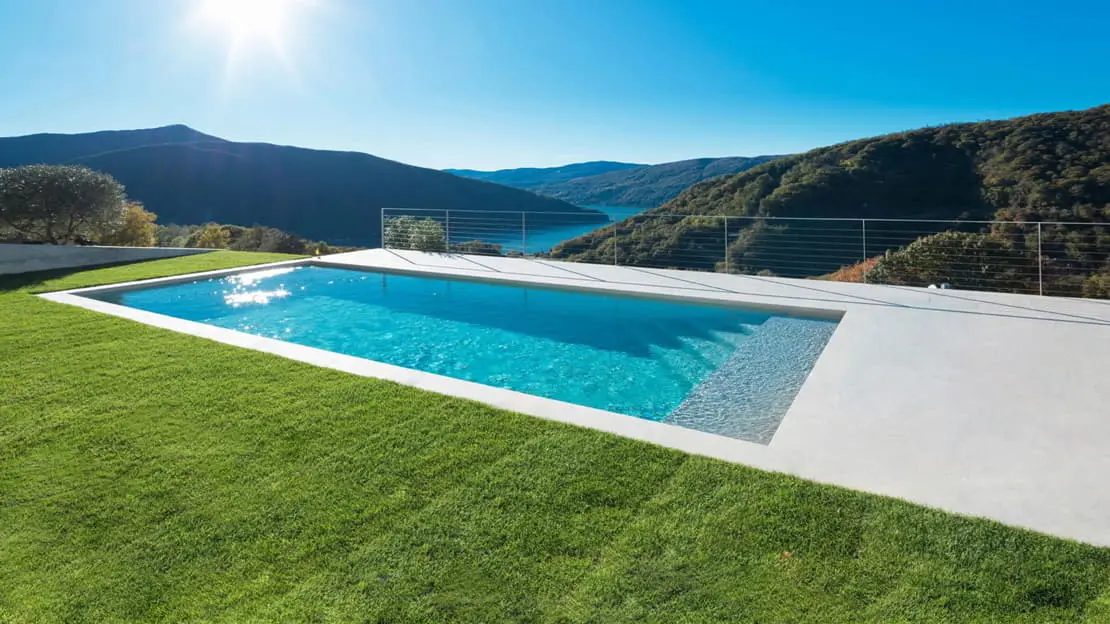
4. Microcement outdoors for all styles
Creating idyllic spaces is the dream we pursue when we think about the exteriors of the house. Enjoying the garden and the pool is synonymous with living moments of tranquility and disconnection. The microcement on the terrace pavement invites to live in peace. In this image we can say that paradise has never been so close.
Where to apply microcement outdoors?
In addition to the visual continuity it provides, microcement in exteriors offers a powerful aesthetic and finishes that do not suffer in the rain, or heat. This functionality combined with the beauty of its finishes is the ideal combination to coat outdoor spaces. Below we present the areas where this coating will shine the most.
Microcement on terraces
Microcement on terraces is one of the most common uses of this exterior coating. The terrace is the ideal place to reconnect with oneself and take a break.
The microcement floors on terraces provide purity, simplicity, and maximum resistance. It is the best way to transform the pavement and provide it with a water-resistant finish. If we also cover walls and floors, the feeling of spaciousness is amplified even more.
Microcement in swimming pools
Microcement in swimming pools enjoys good popularity due to its high adhesion on any type of support. Renovating or building a swimming pool from scratch is an exciting project that requires quality materials to achieve unique finishes with personality.
Microcement is such a versatile material that it adapts to all surfaces offering total integration between the interior of the pool and its crown. If we choose for the microcement to have the same color as the exterior, the continuity is greater and the visual effect is multiplied. In this case, the combination of design and aesthetic harmony translates into spectacular finishes.
However, before applying microcement in swimming pools, a series of key details must be taken into account for the final result to be successful.
- You have to apply a coat of microcement per day, which must be done on sprayed or projected concrete.
- Work early hours of the day to have good workability of the material.
- Respect the amount of resin indicated in the technical sheet of each product.
- Apply sealer to prevent the microcement from being unprotected and to ensure better cleaning.
- Let the application dry for 5 days.
Microcement on facades
Microcement on facades conveys more than just a simple architectural style through a homogeneous and waterproof finish. This coating achieves a modern and contemporary style.
With a microcement facade, not only is a high decoration finish achieved, but it is also a material with high resistance to cracks. A coating with which smooth or rustic finishes can be obtained.
Temperature changes or the passage of time will no longer be a problem to keep the facade in good condition. Microcement, unlike traditional materials, does not need to be painted. It provides any renovation or renewal project with an implicit order and with the highest performance.
With microcement, a simple facade can be transformed into a unique and elegant place.
Application of microcement outdoors
1- Clean the surface
Before applying microcement on an outdoor floor, it is necessary to clean the surface to ensure it is free of dust and grease. It is essential that the support to be coated is clean and with a consolidated base.
2- Prime the support to facilitate the adhesion of the microcement
Once the surface is clean, next you have to apply the adhesion promoter or primer to facilitate the bonding of the microcement base layer with the existing support.
If the surface is absorbent, such as concrete, Concrete Resin will be applied. This product, in addition to being component B of our two-component microcement, is used to facilitate the adhesion of the microcement on this type of supports. If it is a non-absorbent surface, such as tile or terrazzo, Primacrete Plus will be applied before and after the first layer of the preparation microcement.
3- First layer of microcement preparation
After preparing and priming the surface, it's time to apply the first layer of unpigmented preparation microcement. It is important to put a fiberglass mesh for microcement, as it prevents the appearance of cracks and fissures. After leaving the surface, it needs to be sanded.
4- Two layers of finishing microcement
The next step is to apply two layers of finishing microcement with pigment. In the case of outdoor pavements, the best bet is a coarse texture microcement like Concrete Stone
.After the first coat, it must be left to dry between 3 and 6 hours before sanding. The second coat has a drying time of 24 hours. Once the surface is dry, it must be sanded again.
5- Sealing
To ensure a quality finish and professional application, the surface must be sealed. It is a fundamental step to protect the pavement. Two coats of Primacrete Finish will be applied, which acts as a pre-sealing primer, and another two layers of the Concrete Finish WT sealing varnish
.Exterior microcement on walls: how to apply it
Do you want to give a modern and elegant look to the facade of your home or business? The application of exterior microcement on walls can be an excellent option. But, as in any construction work, it is important to follow a series of steps to achieve a durable and attractive result. In this article we explain everything you need to know to effectively apply exterior microcement on walls and obtain a resistant and modern facade that will last you many years.
Before starting, it is important to note that there are different types of microcement available on the market. In this case, we will talk about the products of Luxury Concrete, a brand recognized in the market for high-quality decorative coatings. With Luxury Concrete, you can choose from several types of microcements specifically designed for outdoor applications on walls: Concrete Wall, Monocrete Wall, and Ready-to-use Microcement Easycret. Each one has its own characteristics and advantages, so it is important to choose the most suitable one for each project.
Once the type of microcement has been chosen, it is important to follow a series of steps for proper application. Below, we detail the steps you should follow to effectively apply exterior microcement on walls.
Step 1: Surface Preparation
Before starting to apply the microcement, it is important to prepare the surface. It should be clean, free of dust, grease and other impurities. If the surface is painted, it is important to remove the paint to ensure good adhesion of the microcement. If the surface is damaged, it is important to repair it before starting with the application of the microcement.
Step 2: Application of the primer layer
Once the surface is ready, it is important to apply a primer coat to improve the adhesion of the microcement. In the case of Luxury Concrete, it is recommended to use the Primacret Base primer, which is applied with a roller or a brush. It is important to let the primer dry for a minimum of 6 hours before starting with the application of the microcement.
Step 3: Application of the microcement base layer
After the primer layer, it's time to apply the first layer of base microcement. It's important to apply a double layer of base microcement for greater durability and resistance. That is, a first layer of base microcement should be applied and allowed to dry completely before applying the second layer. This will ensure better adhesion and a more durable result. Unlike the application of microcement on floors, where a single layer of base microcement is used, in the application of exterior microcement on walls it is necessary to apply two layers for greater resistance and durability.
Step 4: Application of the microcement finishing layer
After the second layer of base microcement, the finishing microcement layer is applied. In this case, any of the Luxury Concrete microcements mentioned above can be used, depending on the needs and preferences of the project.
Exterior microcement in swimming pools: how to apply it
If you are thinking of building a pool in your home or business, exterior microcement is an excellent option. This material is resistant to water and sun, making it ideal for the construction of outdoor pools. But, how is exterior microcement applied in pools? In this article, we explain everything you need to know about the process of applying exterior microcement in pools.
Firstly, it is important to highlight that the application of exterior microcement in swimming pools is somewhat more complex than its application on other surfaces. A specific application process and some additional materials are required to ensure a resistant and durable microcement swimming pool.
To start, before applying the exterior microcement in the pool, a layer of resin must be applied. This resin layer is necessary to ensure good adhesion of the microcement on the pool surface and prevent the formation of cracks or fissures in the future. Concrete Resin Pool, developed by Luxury Concrete, is an excellent option for this resin layer.
After applying the resin layer, two layers of Concrete Pool Grand microcement base are applied. The first layer is applied without pigment and the second is already pigmented. This double layer of microcement base is essential to ensure the resistance and durability of the microcement in the pool.
Finally, two layers of Concrete Pool Medium, our finishing microcement for pools, are applied. This finishing layer is what will give the pool its final appearance and will ensure its resistance to water and sun.
Once the exterior microcement has been applied in the pool, it is important to seal it with a suitable product. In this case, we recommend using two coats of Primacrete Finish, which will waterproof the surface of the pool and ensure its long-term resistance.
In summary, the process of applying exterior microcement in swimming pools involves the application of a resin layer, two layers of Concrete Pool Grand base microcement, two layers of Concrete Pool Medium, and sealing with Primacrete Finish. This process is essential to ensure the resistance and durability of the microcement swimming pool. If you want to build a microcement swimming pool, do not hesitate to contact us for more information and professional advice.
Maintenance of microcement outdoors
If you are thinking of applying microcement in your outdoor space, it is important that you know the keys to proper maintenance. And it is that, although microcement is a resistant and durable material, if it is not properly cared for, it can lose its properties and its aesthetic appearance.
Firstly, it is essential that you take into account the weather conditions for the application of microcement. In general, it is not recommended to apply microcement outdoors if it is raining or snowing, as the humidity can affect its adhesion and drying. In addition, the ambient temperature should be between 20 and 25 degrees to ensure optimal drying.
Once the microcement has been applied, it is important to wait at least 7 days before stepping on the pavement, to avoid possible damage and allow it to finish drying and consolidating.
Another fundamental aspect for the maintenance of microcement in exteriors is the periodic application of varnish. As you well know, exterior surfaces are exposed to greater wear due to weather conditions and high temperatures. Therefore, it is advisable to apply a layer of varnish every so often to protect the coating and maintain its original appearance.
Finally, cleaning is another key factor for the maintenance of microcement in outdoor areas. It is important to carry out constant cleaning to prevent dirt from accumulating on the coating, both on walkable and non-walkable surfaces. For this, specific cleaning products for microcement can be used and those that could be aggressive and damage the material should be avoided.
In summary, if you want your outdoor microcement pavement to look in perfect condition for a long time, you should take into account these keys for its proper maintenance: suitable weather conditions for the application, wait for the necessary drying time, periodically apply a layer of varnish and carry out constant cleaning to avoid the accumulation of dirt. In this way, you will be able to enjoy a resistant pavement with an impeccable appearance for many years.
Concrete Stone, the microcement for outdoor use with anti-slip properties
If you have come this far it is because you are interested in knowing more about outdoor microcement for professionals. And you are in the right place, because next we are going to tell you everything you need to know about this versatile and resistant material.
Let's start from the beginning, what is microcement? Microcement is a material composed of cement, water, additives, and pigments. It is a continuous coating, without joints or cuts, that is applied over existing surfaces. It can be used in a multitude of applications, both indoors and outdoors, and offers high-quality finishes.
In this case, we will focus on outdoor microcement, as it is a material that is increasingly being used by architects and decorators for the remodeling of outdoor spaces. The choice of the appropriate microcement for outdoor areas will mainly depend on the finish that is sought, as there are different types of microcements with different properties.
One of the most used microcements for exteriors is the Concrete Stone. This microcement has been specially designed for its application in outdoor areas, and offers a series of advantages over other materials. Among them, its waterproofness and its high resistance capacity stand out, which makes it an ideal coating to achieve durable and elegant finishes.
In addition, Concrete Stone offers anti-slip properties and stone finishes, making it an excellent choice for the cladding of floors and walls in outdoor spaces. This microcement is robust, resistant to abrasion, traffic and temperature changes, making it an ideal material for outdoors.
But, why choose microcement for outdoors? The answer is simple, microcement is a highly resistant and durable material, which makes it a very interesting option for remodeling outdoor spaces. In addition, microcement offers great versatility in terms of its application, which allows creating all kinds of structures and environments depending on where it is applied.
Another advantage of microcement for exteriors is its easy maintenance. Unlike other materials, microcement does not require extensive care or exhaustive maintenance to maintain its original appearance. In addition, microcement is a waterproof material, which prevents the accumulation of moisture and the appearance of mold and fungi on the surfaces where it is applied.
At Luxury Concrete, we specialize in the manufacture of high-quality and durable microcement. All our products are ideal for pavements and facades exposed to weather changes, among other factors. We ensure that our microcements meet all the intrinsic needs when applied in outdoor areas.
Turn outdoor spaces into unique places with finishes that last over time. Discover more inspiration in our web.